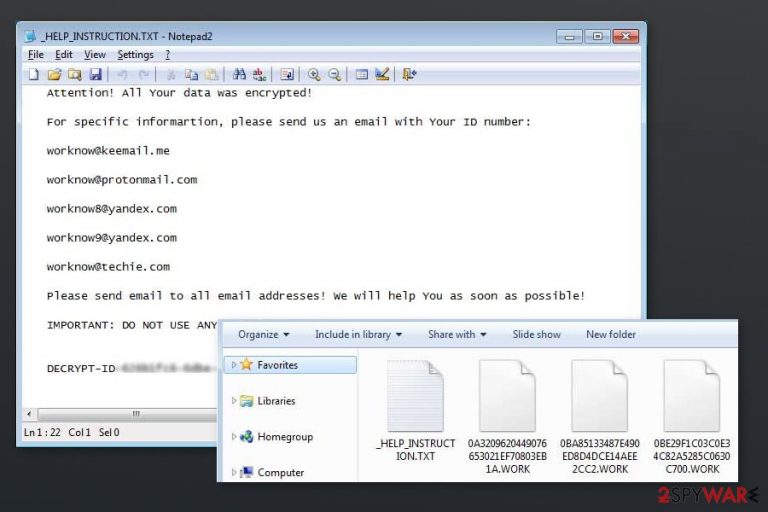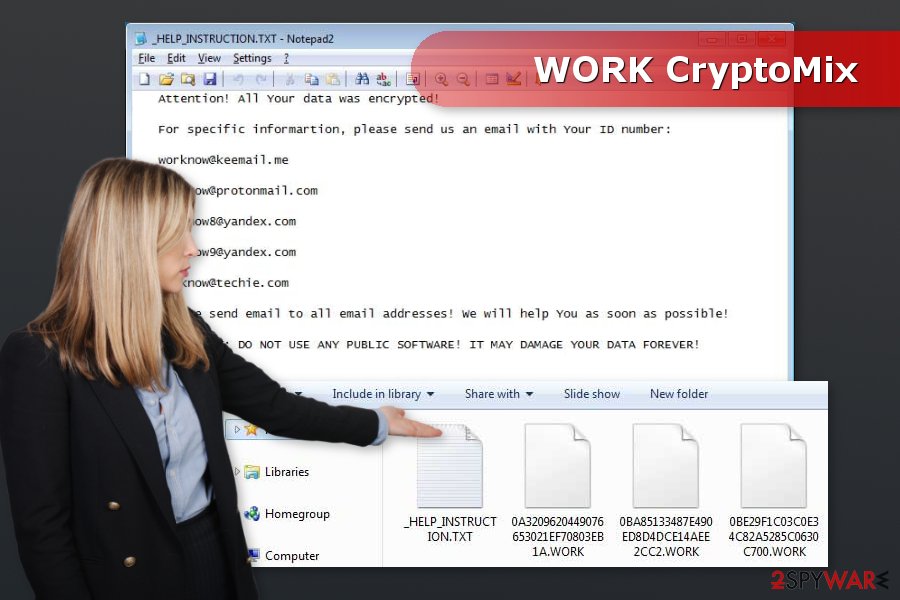WORK ransomware (Recovery Instructions Included) - Removal Instructions
WORK virus Removal Guide
What is WORK ransomware?
WORK ransomware is the latest version of CryptoMix

WORK virus is a file-encrypting malware that belongs to well-known ransomware group CryptoMix. The recent cyber threat uses a combination of RSA-2048 and AES CBC 256-bit encryption and appends .WORK file extension. Additionally, it renames targeted files with 32 random letters and numbers. Thus, files become messy after the attack.
Following data encryption, WORK ransomware creates a “_HELP_INSTRUCTION.TXT” file in each folder that contains encrypted data. It provides data recovery instructions and unique victim’s ID which users have to send to all provided email addresses:
- worknow@keemail.me;
- worknow@protonmail.com;
- worknow8@yandex.com;
- worknow9@yandex.com;
- worknow@techie.com.
Thus, this WORK CryptoMix follows the same ransomware family’s behavior. The full text of the ransom note:
Attention! All Your data was encrypted!
For specific informartion, please send us an email with Your ID number:
worknow@keemail.me
worknow@protonmail.com
worknow8@yandex.com
worknow9@yandex.com
worknow@techie.com
Please send email to all email addresses! We will help You as soon as possible!
IMPORTANT: DO NOT USE ANY PUBLIC SOFTWARE! IT MAY DAMAGE YOUR DATA FOREVER!
DECRYPT-ID-XXX
Nevertheless, cyber criminals try to scare that files will be lost if victims do not follow the instructions; security experts do not recommend having business with evil-minded people. You might not only lose your data but money as well.
There’s no doubt that criminals will ask to pay a ransom in Bitcoins.[1] However, there are no guarantees that once you make a transaction, you will receive a working decryption key. Thus, after WORK ransomware virus attack, you should focus on cleaning your PC from this cyber threat.
Bear in mind that you are dealing with a dangerous crypto-virus that is capable of making sever changes to the computer, such as creating Windows registry keys[2] or injecting malicious code into legitimate processes. Thus, WORK ransomware removal is needed to continue using a computer without hackers breathing behind your back and risking to lose new files or even personal data.
However, do not try to remove WORK virus manually. As we have mentioned, it’s a complicated infection. Thus, you should use FortectIntego or another malware removal tool to delete all ransomware-related components safely.

Criminals remain loyal to the same distribution methods
Usually, CryptoMix family spreads via malicious spam emails. Such letters often pretend to be important or sent from a well-known organization. They always contain malicious attachments which include malware payload. It is dropped on the system as soon as a victim opens such file.
However, malware might also be spread via malware-laden ads that might be placed on legitimate or potentially dangerous websites. It might also be presented as a useful program on various file-sharing sites or networks. Thus, users are advised to be critical about the content they click online no matter where they live – Germany,[3] the United States or Japan – WORK ransomware might reach you wherever your computer is located.
Termination guide of the .WORK file virus
We have already told you that WORK virus removal is completed using reputable malware removal tools. Our team recommends using FortectIntego, SpyHunter 5Combo Cleaner or Malwarebytes; however, you can use your preferred software as well. The most important part is that you have to use updated program that is capable of detecting recent cyber infections.
However, you should also reboot the computer to Safe Mode with Networking or try System Restore method that allows disabling the virus. Malware might be resistant and block antivirus software. Thus, you have to complete additional steps to remove WORK ransomware entirely. Follow the guide below.
Getting rid of WORK virus. Follow these steps
Manual removal using Safe Mode
Follow these steps to disable WORK ransomware and run automatic elimination
Important! →
Manual removal guide might be too complicated for regular computer users. It requires advanced IT knowledge to be performed correctly (if vital system files are removed or damaged, it might result in full Windows compromise), and it also might take hours to complete. Therefore, we highly advise using the automatic method provided above instead.
Step 1. Access Safe Mode with Networking
Manual malware removal should be best performed in the Safe Mode environment.
Windows 7 / Vista / XP
- Click Start > Shutdown > Restart > OK.
- When your computer becomes active, start pressing F8 button (if that does not work, try F2, F12, Del, etc. – it all depends on your motherboard model) multiple times until you see the Advanced Boot Options window.
- Select Safe Mode with Networking from the list.

Windows 10 / Windows 8
- Right-click on Start button and select Settings.

- Scroll down to pick Update & Security.

- On the left side of the window, pick Recovery.
- Now scroll down to find Advanced Startup section.
- Click Restart now.

- Select Troubleshoot.

- Go to Advanced options.

- Select Startup Settings.

- Press Restart.
- Now press 5 or click 5) Enable Safe Mode with Networking.

Step 2. Shut down suspicious processes
Windows Task Manager is a useful tool that shows all the processes running in the background. If malware is running a process, you need to shut it down:
- Press Ctrl + Shift + Esc on your keyboard to open Windows Task Manager.
- Click on More details.

- Scroll down to Background processes section, and look for anything suspicious.
- Right-click and select Open file location.

- Go back to the process, right-click and pick End Task.

- Delete the contents of the malicious folder.
Step 3. Check program Startup
- Press Ctrl + Shift + Esc on your keyboard to open Windows Task Manager.
- Go to Startup tab.
- Right-click on the suspicious program and pick Disable.

Step 4. Delete virus files
Malware-related files can be found in various places within your computer. Here are instructions that could help you find them:
- Type in Disk Cleanup in Windows search and press Enter.

- Select the drive you want to clean (C: is your main drive by default and is likely to be the one that has malicious files in).
- Scroll through the Files to delete list and select the following:
Temporary Internet Files
Downloads
Recycle Bin
Temporary files - Pick Clean up system files.

- You can also look for other malicious files hidden in the following folders (type these entries in Windows Search and press Enter):
%AppData%
%LocalAppData%
%ProgramData%
%WinDir%
After you are finished, reboot the PC in normal mode.
Remove WORK using System Restore
System Restore also helps to disable the virus.
-
Step 1: Reboot your computer to Safe Mode with Command Prompt
Windows 7 / Vista / XP- Click Start → Shutdown → Restart → OK.
- When your computer becomes active, start pressing F8 multiple times until you see the Advanced Boot Options window.
-
Select Command Prompt from the list

Windows 10 / Windows 8- Press the Power button at the Windows login screen. Now press and hold Shift, which is on your keyboard, and click Restart..
- Now select Troubleshoot → Advanced options → Startup Settings and finally press Restart.
-
Once your computer becomes active, select Enable Safe Mode with Command Prompt in Startup Settings window.

-
Step 2: Restore your system files and settings
-
Once the Command Prompt window shows up, enter cd restore and click Enter.

-
Now type rstrui.exe and press Enter again..

-
When a new window shows up, click Next and select your restore point that is prior the infiltration of WORK. After doing that, click Next.


-
Now click Yes to start system restore.

-
Once the Command Prompt window shows up, enter cd restore and click Enter.
Bonus: Recover your data
Guide which is presented above is supposed to help you remove WORK from your computer. To recover your encrypted files, we recommend using a detailed guide prepared by 2-spyware.com security experts.WORK decryptor is not available yet. However, if you do not have backups, try alternative recovery methods that MIGHT restore some of the files.
If your files are encrypted by WORK, you can use several methods to restore them:
Use Data Recovery Pro
It's not a specific ransomware decryptor. However, this recovery tool already helped numerous victims of ransomware.
- Download Data Recovery Pro;
- Follow the steps of Data Recovery Setup and install the program on your computer;
- Launch it and scan your computer for files encrypted by WORK ransomware;
- Restore them.
Take advantage of Windows Previous Versions
This Windows feature allows accessing individual files before ransomware attack if System Restore was enabled before ransomware attack.
- Find an encrypted file you need to restore and right-click on it;
- Select “Properties” and go to “Previous versions” tab;
- Here, check each of available copies of the file in “Folder versions”. You should select the version you want to recover and click “Restore”.
Use ShadowExplorer
If WORK ransomware did not delete Shadow Volume Copies, this tool might help you:
- Download Shadow Explorer (http://shadowexplorer.com/);
- Follow a Shadow Explorer Setup Wizard and install this application on your computer;
- Launch the program and go through the drop down menu on the top left corner to select the disk of your encrypted data. Check what folders are there;
- Right-click on the folder you want to restore and select “Export”. You can also select where you want it to be stored.
WORK CryptoMix decryptor is not available yet.
Finally, you should always think about the protection of crypto-ransomwares. In order to protect your computer from WORK and other ransomwares, use a reputable anti-spyware, such as FortectIntego, SpyHunter 5Combo Cleaner or Malwarebytes
How to prevent from getting ransomware
Access your website securely from any location
When you work on the domain, site, blog, or different project that requires constant management, content creation, or coding, you may need to connect to the server and content management service more often. The best solution for creating a tighter network could be a dedicated/fixed IP address.
If you make your IP address static and set to your device, you can connect to the CMS from any location and do not create any additional issues for the server or network manager that needs to monitor connections and activities. VPN software providers like Private Internet Access can help you with such settings and offer the option to control the online reputation and manage projects easily from any part of the world.
Recover files after data-affecting malware attacks
While much of the data can be accidentally deleted due to various reasons, malware is one of the main culprits that can cause loss of pictures, documents, videos, and other important files. More serious malware infections lead to significant data loss when your documents, system files, and images get encrypted. In particular, ransomware is is a type of malware that focuses on such functions, so your files become useless without an ability to access them.
Even though there is little to no possibility to recover after file-locking threats, some applications have features for data recovery in the system. In some cases, Data Recovery Pro can also help to recover at least some portion of your data after data-locking virus infection or general cyber infection.
- ^ Danny Palmer. Ransomware's bitcoin problem: How price surge means a headache for crooks. ZDNet. Breaking news, analysis, and research keeps business technology professionals in touch with the latest IT trends, issues and events.
- ^ Roger A. Grimes. Infected with malware? Check your Windows registry. CSO. Security news, features and analysis about prevention, protection, and business innovation.
- ^ DieViren. DieViren. Cyber security news.







